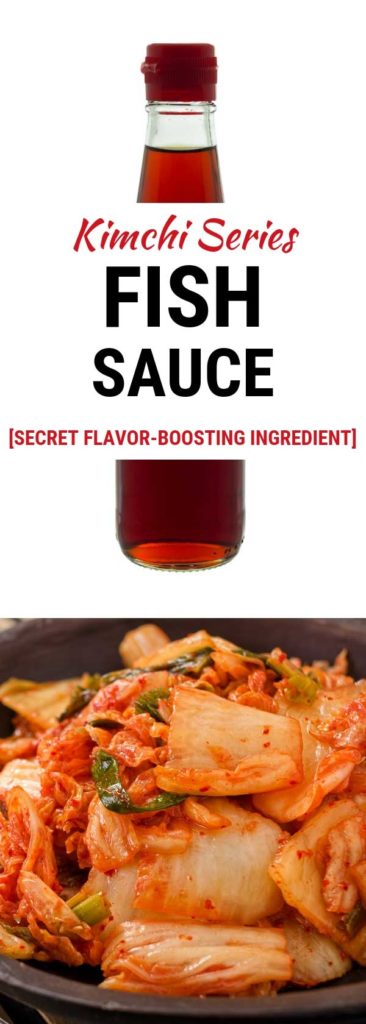Kimchi is the common name for any vegetable fermented in traditional Korean style of lactic-acid fermentation, the most common vegetable combination being napa cabbage with daikon radish, and green onions seasoned with Korean red pepper powder, fish sauce, salted shrimp, ginger and garlic. Called Poggi Kimchi, this traditional version of cabbage kimchi is made during kimjang (the fall cabbage harvest) and is intended to last through the winter months.
When I first learned to ferment, I couldn’t stomach the thought of fish sauce and salted shrimp, so I left it out, simplified the preparation method and instead made Kimchi-Style Sauerkraut. I love it. It’s my eldest son’s favorite, but now I’m ready to make the real thing, complete with fish sauce and… maybe, that salted shrimp.
Many of us who didn’t grow up eating kimchi with three meals each day may not be comfortable with the thought of using fish sauce in a ferment. In this post, I aim to change that fishy, unease into flavorful wonder. I’ve recently learned why fish sauce is such a powerful, key ingredient in the success of fermenting your own mouthwatering kimchi.
Ready to raise the bar on your fermentation?
The Romans, incidentally, knew about fermented fish sauce. Theirs was called garum and it was the liquid produced by salted and fermented fish intestines.
Key Takeaways
- Don’t let a “fear of the fishy” prevent you from using powerful, umami-rich fish sauce in your kimchis.
- When purchasing fish sauce, find a brand that has only anchovies and salt as ingredients. I use Red Boat fish sauce which I’m told can now be found – in the US – at Costco and Trader Joe’s and on Amazon.
- Use 1-3 tablespoons of fish sauce in a one-quart batch of kimchi.
The Kimchi Series: Learn to Ferment Kimchi with Confidence
This article is part of a set of blog posts in which you learn about the key ingredients in kimchi, the various types of kimchi, ways to ferment kimchi, and make a variety of kimchis such as Daikon Radish Cube Kimchi (Kkakdugi), Napa Cabbage Kimchi (Baechu), Brussels Sprouts Kimchi, and Stuffed-Cabbage Kimchi (Poggi). Perhaps, even Instant Apple, Persimmon, and Pear Kimchi (Saqyua, Gaam, Bae).
A Fun Fact to Motivate You to Add Kimchi to Your Diet
Due to fermented ingredients—like fish sauce—in many kimchi recipes, a single variety of kimchi might contain more than one hundred different types of microorganisms. And, a single gram of that fermented kimchi contains some 100 million lactic acid bacteria. From Cultured by Katherine Harmon Courage.
Techniques & Ingredients
Fish Sauce, the Secret Ingredient to Transform Your Kimchi
Gochugaru, Korean Red Pepper Powder
Stocking Your Kimchi Pantry: Staples, Fresh Ingredients, Basic Techniques
Recipes
What is Fish Sauce?
Fish sauce is a liquid condiment prepared from fermented anchovies and salt. It is used as a staple seasoning in the cuisines of Southeast and East Asia, particularly Indonesian, Burmese, Cambodian, Filipino, Thai, Lao, and Vietnamese AND is a key ingredient in many styles of kimchi. For many, however, just the thought of fish sauce can be rather off-putting. After all, who would want the fishy aroma from fermented anchovies wafting through their kitchen?
Don’t make the mistake – as I did – of waiting years to incorporate this flavor-unleashing ingredient into your kitchen. Once your taste the incredible flavors fish sauce unlocks, you will be dousing every dish in your kitchen with it. Learn to use it properly, and it becomes a robust flavor booster, with no trace of fishiness remaining.
The secret behind this powerful ingredient?
Umami!
The word Umami has been around for over a century, coined in 1909 by Kikunae Ikeda, a Japanese chemist.
Umami, the Taste of Satisfaction
Umami is often referred to as the fifth taste, joining sweet, salty, sour, and bitter. More specifically, it is a term to measure the level of glutamates (along with inosinates and guanylates) in certain ingredients. These glutamates – the same stuff that comprises MSG, or monosodium glutamate – are naturally occurring in many of your favorite foods and sauces:
Parmesan cheese,
soy sauce,
tomato paste,
cured ham,
beef and beef stock,
anchovies,
sardines,
cheddar cheese,
porcini or shiitake mushrooms,
olives,
roasted tomatoes,
miso,
kombu kelp, and
Worcestershire sauce, to name a “few.”
Through my research for this article, I happened across the Umami Information Center, a non-profit organization established in 1982 to convey information about umami as a basic taste as well as general information about umami in an accurate manner based on facts.
There are a great variety of traditional seasonings and foods in the world as evidenced in their map below. Most of them are fermented, dried, or salted for the purpose of long preservation. What a flavorful world we have! Makes me hungry.
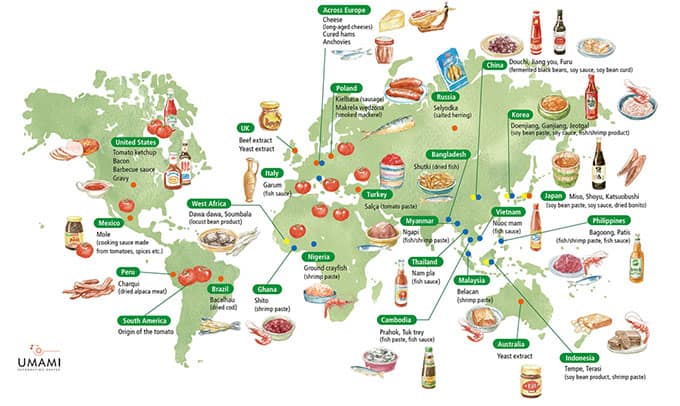
Source: Umami Information Center Click HERE for their full-screen version.
“When you ingest umami-rich molecules, everything you eat with them becomes more beautiful: meaty, salty, flavorful, delicious.” – Barb Stucky, Taste What You're Missing: The Passionate Eater's Guide to Why Good Food Tastes Good
Incidentally, Stuckey attributes our fondness for umami to the fact that both breast milk and amniotic fluid are full of glutamates. “We’re literally floating in umami until we enter the world,” she says.
And when you combine complementary umami boosters, such as cheese on a burger or Parmesan and anchovies in a salad, flavors are magnified by as much a thirtyfold.
Kimchi, Fermentation & Umami

Through the fermentation process, protein molecules in kimchi are broken down into free amino acids which raise the level of the umami compound glutamate. Now I’m beginning to understand why my sauerkraut and kimchi tastes so very good. It’s the umami secret.
“We also know that the umami component of food increases as a result of processing such as ripening and fermentation. Many traditional foodstuffs from around the world, such as soy sauce and other fermented condiments made from grain, fish sauces such as Thailand’s nam pla and nuoc mam from Vietnam, and cheeses are excellent sources of umami.” – Umami Information Center
Taken from the UMAMI Information Center, this graph shows how fermentation increases the levels of glutamate, along with other amino acids, in kimchi.
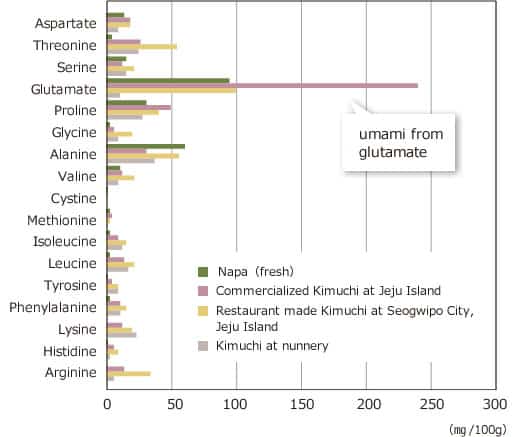
Source: Umami Information Center
Among vegetables, napa cabbage is rich in umami: 100g contains 94mg of glutamate. In the three varieties of kimchi, glutamate, proline, and alanine are prominent. The kimchi at the nunnery in Sangju does not contain seafood due to Buddhist teachings. The commercialized product at Jeju Island and the kimchi of the restaurant in Seogwipo have more amino acids than fresh napa and kimchi of the nunnery, which imply that the fermented ingredients in the seasoning have something to do with the result.
Glutamate Levels of Umami-Rich Products (mg/100g)
By measuring the naturally occurring glutamate levels in food, we know how much how big of an umami punch it can deliver. Who doesn’t love those crystalized, crunchy bits in Parmesean cheese?
| Umami-Rich Food | mg of glutamate in 100 grams of food item |
| Natto | 140 |
| Fish Sauce | 950 |
| Oyster Sauce | 900 |
| Soy Sauce | 400~1700 |
| Miso | 200~700 |
| Kimchi | 240 |
| Parmigiano Reggiano | 1680 |
| Cheddar Cheese-aged 4 mos. | 78 |
| Worcestershire Sauce | 34 |
| Marmite | 1960 |
Any Marmite (discussed below as an alternative to fish sauce) fans out there?
How is Fish Sauce Made?
Fresh and small whole fish, usually anchovies, are coated in sea salt and packed in large wooden barrels and left to ferment for 9-12 months. Over time, the natural bacteria break down the fish, and the briny, fishy, savory liquid that forms is collected and filtered before bottling.
The method has been adopted by Thai, Vietnamese, Chinese peoples. Even the ancient Roman Empire produced a version of fish sauce called garum.
Why Does Fish Sauce Smell Bad?
“The Fish Sauce here doesn’t stink. It has a deep dark aroma of soy sauce.” ~Chef Tu David Phu
In this article on Chopsticks Alley, chef Tu David Phu discusses with Danny Tran, 4th generation owner of Son Fish Sauce why some fish sauce stinks.
The reason for stinky fish sauce?
Most fish sauce is smelly because it is made from anchovy extracts. Old anchovies or decaying fish is dried, then pulverized into a paste that includes additives such as hydrolyzed protein (MSG), sugar, and water.
Take time to buy the fresh sauce prepared in the traditional manner.
Fish Sauce was recently included in Bon Appetit’s list of pantry essentials and appears on tables at Michelin Star-rated restaurants.
Purchasing the Best Fish Sauce
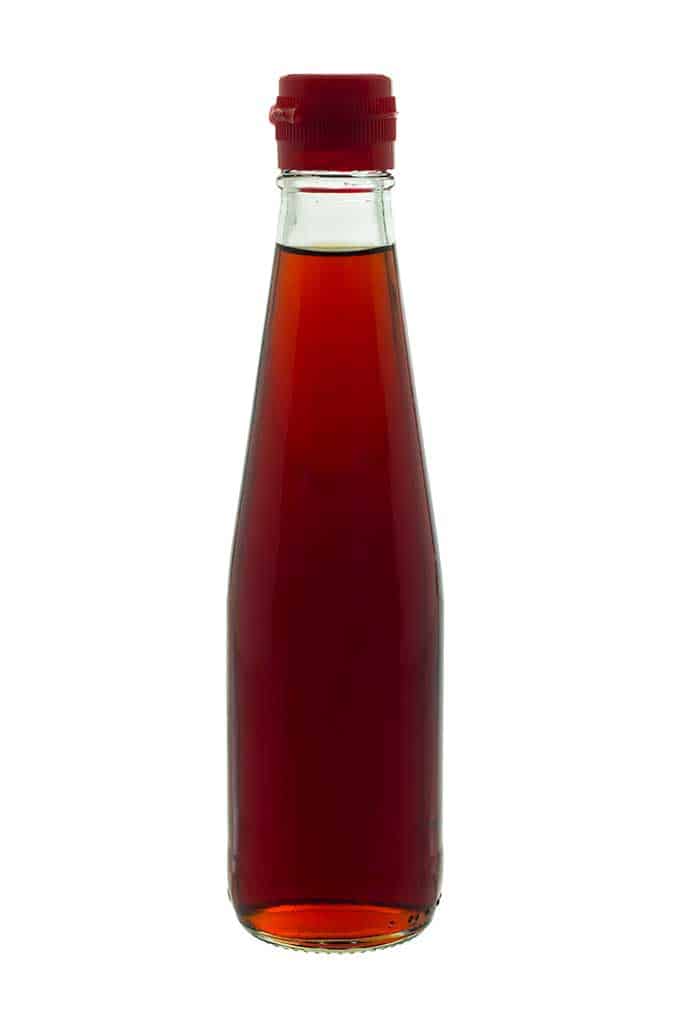
There are hundreds of varieties of fish sauce out there, and if you visit an Asian market, you’ll have many to choose from. The difficulty is in finding one that contains just anchovies and salt. You’ll find that many of the lower priced brands add extra flavorings like sugar and spices to try to cover up a more pronounced fish aroma.
What to look for?
Ingredients
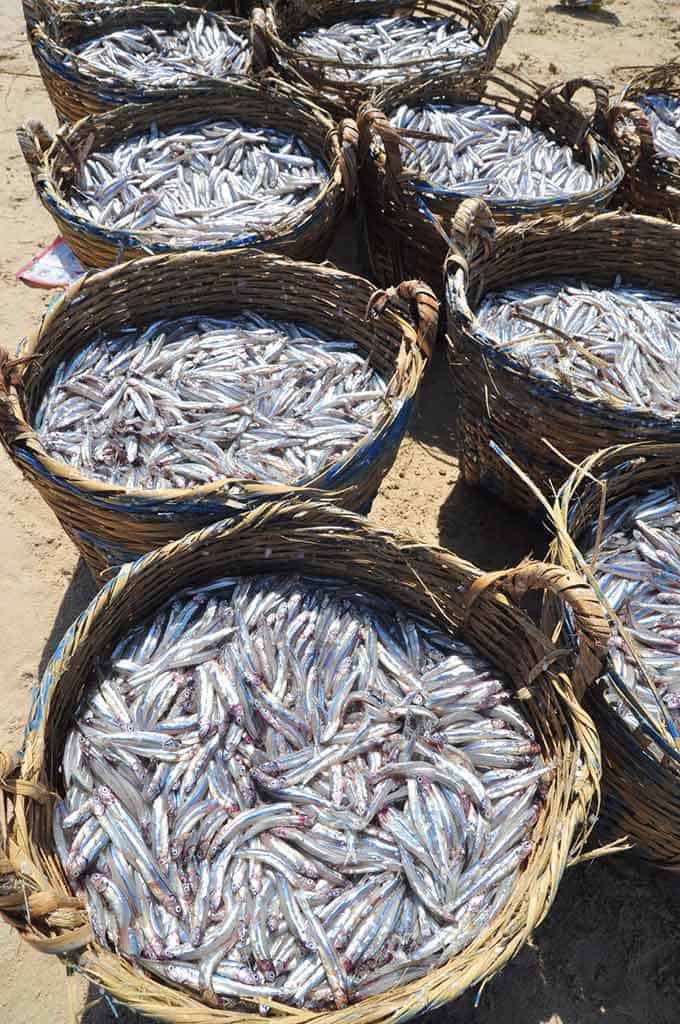
Good fish sauce should contain just fish and salt, nothing more. There should be no fructose, hydrolyzed protein, preservatives, MSG, or added water. Does that sound like shopping for sauerkraut?
Most of the better brands are made with anchovies with cá cơm (black anchovy) being very popular in Vietnam for fish sauce production. The sauce made from these black anchovies is usually more aromatic and less salty than that from mackerel or beltfish.
If the only fish sauce you can find contains sugar, as in , go ahead and use that until a better choice can be found.
Color
The color should be dark amber. As you shake it lightly, you’d see air bubble emerge, which shows it has a lot of protein and umami inside. Quality fish sauce is also thicker and will stick to your fingers.
Smell
Fish sauce should smell like fish, but it should not stink or smell foul. Fish sauce that smells off will taste off.
Thirty to forty tons of fish yields about 10,000 liters of fish sauce.
Taste
Good fish sauce tastes salty, and then sweet. It should never taste bitter.
Protein Content
The degrees (°N) on the label of Vietnamese fish sauce represent the protein content. The higher the value, the higher the protein content and the umami. The degrees of Vietnamese fish sauce varies from 20°N to 60°N.
According to Son Fish Sauce, however:
Higher protein content does not mean better fish sauce as anything higher than 43* degrees protein content can only come from a bigger fish or from a mechanical machine enhanced process. Bigger fishes eat smaller fishes vs anchovies only eating plankton (plant) as well as having a much smaller stomach.
Origin
Origin is the final determinant in the quality of the fish sauce. There are three major fish sauce production areas in Vietnam: the southernmost island of Phú Quốc, Phan Thiết, and Nha Trang. You should see the sauce’s origin marked on the bottle with Phú Quốc being the most desired of the three. Not only raising more fragrant fish, but the island also insists on the traditional production method, using natural sea salt and fermenting in traditional wooden barrels.
Last year, the European Union started recognizing fish sauce from the Vietnam island of Phu Quoc as a “Protected Designation of Origin,” along the lines of Champagne for sparkling wine or Parmigiano-Reggiano for hard Italian cheese.
First Press?
Fish sauce made from the first press or draw has a more pure, sharp taste than subsequent draws from the fermenting fish.
Recommended Brands
Red Boat Fish Sauce
- JUST TWO INGREDIENTS: We use only sea salt and black anchovies caught off of the crystal clear...
- 100% PURE FLAVOR: Our first press fish sauce is first press and 40N, which means that it has...
- FERMENTED FOR A YEAR: Anchovies and sea salt are slowly fermented in carefully selected wooden...
Red Boat is made using only a traditional fermentation method, a unique two-hundred-year-old artisanal process using only the freshest cá cơm” (black anchovy), salted minutes after leaving the sea then aged for over a year in traditional wooden barrels. Red Boat anchovies are sourced exclusively from the crystal clear waters off the Phu Quoc Island archipelago.
Red Boat fish sauce contains only anchovies and salt and has a more savory and almost nutty profile. It tastes incredibly fresh and not super fishy.
Son Fish Sauce
- 100% Pure Natural, No MSG, No Additives or Preservatives, Gluten-Free, No Shellfish.
- Only 2 Ingredients - Wild Anchovy + Sea Salt.
- Small-batch, Extra Virgin, First Press Artisanal Quality Fish Sauce!
Son’s own fleet of boats harvest wild caught anchovies year round from the waters around Son Rai Island in the western southern region of Vietnam. According to their website, what makes their fish sauce special is that the anchovies around Son Rai Island have very small stomachs, thus allowing the fish sauce to have a high protein content and a much more fragrant smell. Once the anchovies are caught, they are then salted right away on the boat with local sea salt. This method allows the fermentation process to start right.
I haven’t tried Son Fish Sauce but I assume it would be very similar to Red Boat Fish Sauce. If it is out of stock on Amazon, it is also available from on their website.
Haku Iwashi Whisky Barrel Aged Fish Sauce, The Expensive Stuff (Contains Sugar)
- Add a perfect salty funk to your favorite dishes: Our whiskey barrel aged fish sauce is a...
- What is in our classic gourmet sauce? Prepared with centuries old ancestral methods, our...
- Savory that is to die for: Our uniquely prepared dark fish sauce is aged for 2 years and...
Haku Iwashi Whisky Barrel Aged Fish Sauce is aged for a year in Japanese whiskey barrels made from Mizunara (Japanese Oak) hardwood. Made of just anchovies, salt, and sugar, this fish sauce is fermented for an intense briny flavor.
Thai Kitchen Fish Sauce (Contains Sugar)
No products found.
Readily available at many grocery stores, Thai Kitchen Premium Fish Sauce is made only from the careful first pressing of salted anchovies and provides that essential savory flavor we’re looking for.
Storing Your Fish Sauce
Quality fish sauce degrades with time. Much like wine, fish sauce is subject to oxidation.
Once its opened, ideally consume within 30 days for the best taste and flavor. Always keep the cap closed to prevent air exposure, and if you like, refrigerate after opening.
Under certain conditions, harmless salt crystals may form on the bottom of the bottle which does not affect the fish sauce in any way, just nature taking its course.
The leftover fishy solids from making fish sauce are often sold as pig food.
Common Alternatives to Fish Sauce? Vegan Option?
All of these substitutions are rich in umami and will add depth to your kimchi. I made a batch of kimchi using one tablespoon of miso (in place of the fish sauce and salted shrimp) and liked the results, though the flavor profile was not as complex as the batch of kimchi using fish sauce and salted shrimp.
Vegan Mian has a recipe for a vegan fish sauce that uses pineapple juice and soy sauce. Brilliant Vegan Fish Sauce
Miso
Miso is made from fermented soybeans and is a thick paste-like substance with a great umami flavor.
Coconut Aminos
Coconut aminos is a delicious sauce made from coconut sap. It is dark, rich, salty and slightly sweet in flavor. It resembles a light soy sauce or tamari (wheat-free soy sauce), but it is soy free and gluten free.
Worcestershire Sauce
If you’re new to fish sauce or are hesitant to give it a try, then you might want to start off with Worcestershire sauce, which contains anchovies as one of its main ingredients. It is milder than fish sauce.
Soy Sauce
Soy sauce is a condiment frequently used in Chinese and Japanese cuisine. It’s dark brown color is punctuated with a salty, savory, umami flavor. The flavor of soy sauce comes from fermented soybeans, along with roasted grains (wheat), salt, water, and a mold or yeast culture.
Vegemite
Vegemite is a thick, black, Australian food spread made from leftover brewers’ yeast extract with various vegetable and spice additives.
Marmite
Marmite is a dark brown, sticky condiment made from yeast and vegetable extracts. It is the UK version of Vegemite. It is often spread onto bread and crackers, as well as being used to enhance meat and fish dishes.
How to Use Fish Sauce as a Flavor Boost
First off, remember that fish sauce is a condiment, so start off with a small splash at first, probably less than a teaspoon at a time in a dish where you would otherwise add salt. Taste as you go, as a little will go a long way. And think of combining it with an acid: a squeeze of lemon juice, a splash of vinegar.
“Often, adding acid is the only way to temper a surfeit of umami—which is why sushi, dipped in soy sauce, is served with pickled ginger, or hamburgers are especially delicious with dill pickles.”
And, which is why the acid of fermentation brings out umami. Cool!
Cook It. Turns out, fish sauce only loses the funk after it cooks. Drizzle it on after the fact, and you’re dealing with a completely different, if still wonderful, ingredient. But give the fish sauce some time to mingle and for heat to do its thing, and it melds into the dish, transforming into something else entirely.
Add it to tomato-based sauces.
Use fish sauce to boost flavors in sauteed greens.
When cooking eggs, add 1/2 teaspoon of fish sauce per egg for a silkier taste, with no real hint of fishiness.
Add a bit to salad dressings tempering the stuff with some lemon or lime juice.
In marinades, fish sauce works especially well. For your next batch of steak tacos, mix 1 pound of skirt steak with 1 tablespoon of fish sauce, along with a couple cloves of garlic, and marinate for a few hours.
In kimchi!!!
Note: Fish Sauce makes a great gift for a special friend who is into spicy foods and might want to try their hand at making kimchi. See more gift ideas in my fermentation gift guide.
References
Wait, What is Fish Sauce Anyway?
Five Expert Tips for Choosing the Best Fish Sauce
Mmm, Mmm….Umami: Why Roasted Tomatoes, Fish Sauce and Parmesan Cheese Make Everything Taste So Good
16 Healthy Foods Packed with Umami Flavor
Umami Information Center
Will you be adding fish sauce to your next batch of kimchi?
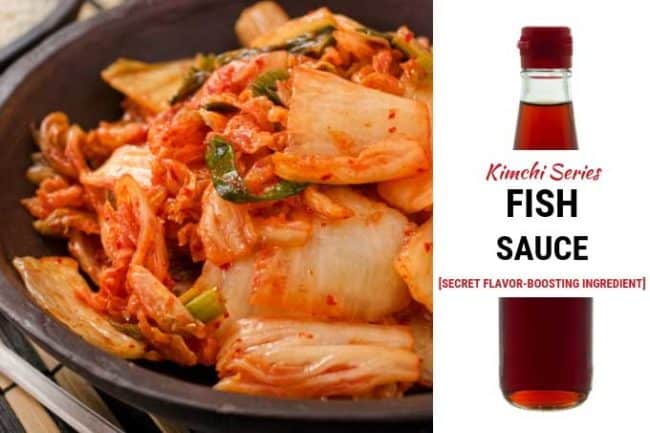
Last update on 2024-07-26 / Affiliate links / Images from Amazon Product Advertising API

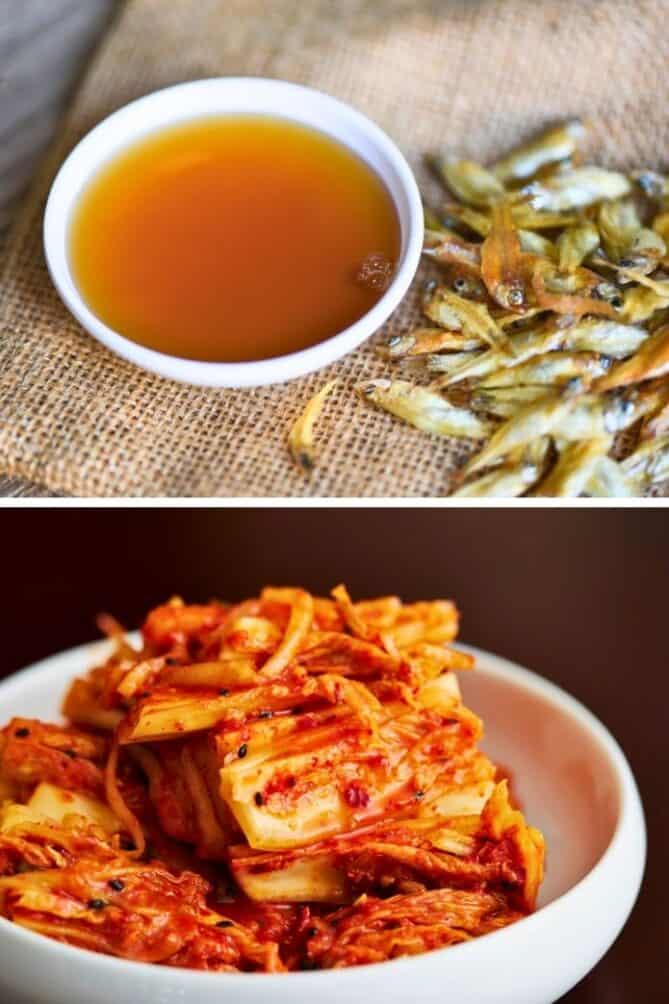

 This post may contain affiliate links which won’t change your price but will share some commission.
This post may contain affiliate links which won’t change your price but will share some commission.